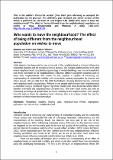Files in this item
Who wants to leave the neighbourhood? The effect of being different from the neighbourhood population on wishes to move
Item metadata
| dc.contributor.author | Van Ham, Maarten | |
| dc.contributor.author | Feijten, P | |
| dc.date.accessioned | 2016-01-06T13:40:04Z | |
| dc.date.available | 2016-01-06T13:40:04Z | |
| dc.date.issued | 2008-05 | |
| dc.identifier | 438390 | |
| dc.identifier | 7300bc28-c36f-43ea-be60-90eea720bca8 | |
| dc.identifier | 000256630100009 | |
| dc.identifier | 43149122866 | |
| dc.identifier.citation | Van Ham , M & Feijten , P 2008 , ' Who wants to leave the neighbourhood? The effect of being different from the neighbourhood population on wishes to move ' , Environment and Planning A , vol. 40 , no. 5 , pp. 1151-1170 . https://doi.org/10.1068/a39179 | en |
| dc.identifier.issn | 0308-518X | |
| dc.identifier.other | ORCID: /0000-0002-2106-0702/work/64697512 | |
| dc.identifier.uri | https://hdl.handle.net/10023/7978 | |
| dc.description.abstract | Little attention has been paid to date to the role of the neighbourhood as a factor influencing residential mobility and the residential choice process. The question addressed here is to what extent neighbourhood characteristics (percentage of rented dwellings, low-income households, and ethnic minorities in the neighbourhood) influence different categories of residents to wish to leave their neighbourhood. The answer to this question can enhance our understanding of residential mobility and of the mechanisms causing segregation by income and ethnic groups. We use data from the 2002 Netherlands Housing Demand Survey, enriched with neighbourhood characteristics. Whether or not people wish to leave their neighbourhood is estimated using a multilevel logistic regression model with cross-level interaction effects between individual and neighbourhood characteristics. The main result shows that, with an increasing percentage of people from an ethnic minority in the neighbourhood, more people have the wish to leave the neighbourbood. However, this is to a lesser extent the case for members of ethnic minorities themselves. | |
| dc.format.extent | 20 | |
| dc.format.extent | 354670 | |
| dc.language.iso | eng | |
| dc.relation.ispartof | Environment and Planning A | en |
| dc.subject | Residential-mobility | en |
| dc.subject | Segregation | en |
| dc.subject | Behavior | en |
| dc.subject | Outcomes | en |
| dc.subject | City | en |
| dc.subject | Deprivation | en |
| dc.subject | Preferences | en |
| dc.subject | Netherlands | en |
| dc.subject | Opportunity | en |
| dc.subject | Hypothesis | en |
| dc.subject | H Social Sciences (General) | en |
| dc.subject.lcc | H1 | en |
| dc.title | Who wants to leave the neighbourhood? The effect of being different from the neighbourhood population on wishes to move | en |
| dc.type | Journal article | en |
| dc.contributor.institution | University of St Andrews. School of Geography and Geosciences | en |
| dc.contributor.institution | University of St Andrews. Geography & Sustainable Development | en |
| dc.identifier.doi | https://doi.org/10.1068/a39179 | |
| dc.description.status | Peer reviewed | en |
This item appears in the following Collection(s)
Items in the St Andrews Research Repository are protected by copyright, with all rights reserved, unless otherwise indicated.

